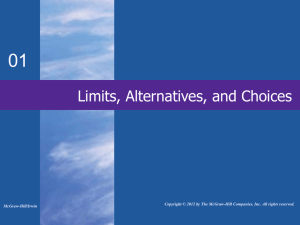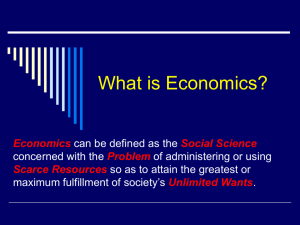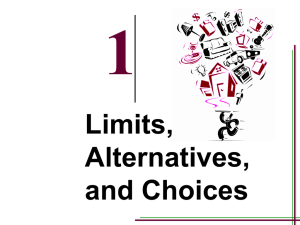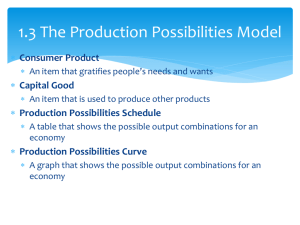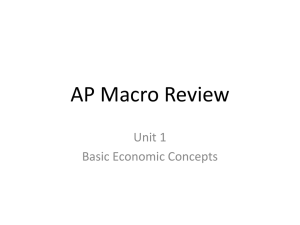Chapter X
advertisement
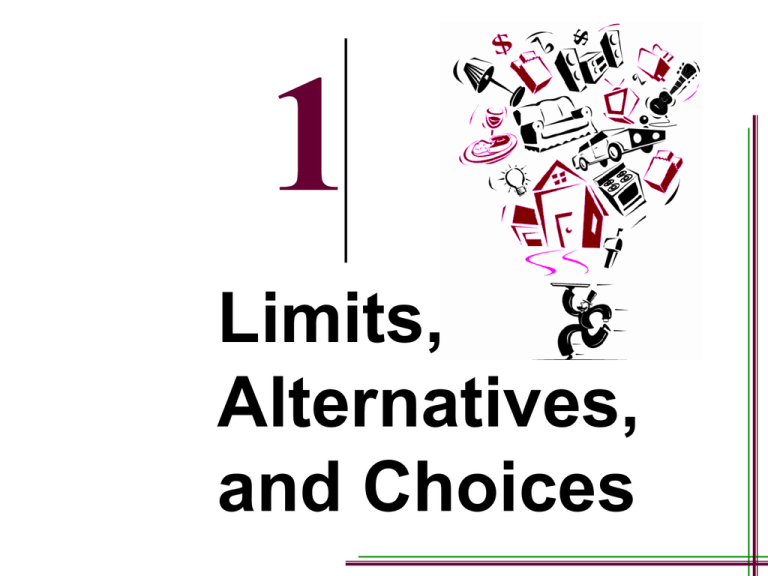
1 Limits, Alternatives, and Choices 1-1 Learning Objectives In this chapter you will learn about: 1. The definition of economics and the features of the economic perspective. 2. The role of economic theory in economics. 3. The distinction between microeconomics and macroeconomics. 4. The categories of scarce resources and the nature of the economizing problem. 5. The production possibilities analysis, increasing opportunity costs, and economic growth. 1-2 Question # 1 • Suppose you have a KWD 100 for shopping. • The cost of the shopping list in your mind is KWD 280. • What are you going to do? 1-3 Economics Defined Economics is the social science concerned with how individuals, institutions, and society make optimal (best) choices under conditions of scarcity. • Economic Perspective Economists view things from a unique perspective, or economic way of thinking. • Scarcity and choice • Scarcity restricts options and demands choices. The core of economics is the idea that “there is no free lunch”. What is free from your perspective is not free from the societal perspective. (Flash film 1) 1-4 • Scarce inputs (land labor and capital..) could be used to produce several things. When they are used to produce a certain product, we sacrifice other goods, this is called the “Opportunity Cost”, or the cost of choice. (Flash film 2) • Purposeful Behavior • Economic behavior reflects “rational self interest”. Individuals look for and pursue opportunities to increase their utility. Because they weigh costs and benefits their economic decisions are purposeful. Consumers, business and government are purposeful. • Purposeful behavior does not mean that people and institutions don’t make mistakes. Nor that people decisions are unaffected by emotions or decisions of those around them. It simply means that people make decisions with some desired outcomes in mind. 1-5 • Rational self-interest is not the same as selfishness. People make personal sacrifices to others (this maximizes the giver’s satisfaction). Marginal Analysis: Benefits and Costs • To economists, marginal means extra, additional or change in. most decisions involve changes in status quo. • Each option involves marginal benefits and marginal costs. We should compare marginal benefits with marginal costs. In general the marginal cost of an action should not exceed its marginal benefits. Optimum position is reached when MB = MC 1-6 Theories, principles and Models • Economics relies on the scientific method, which consists of several elements: 1. 2. 3. 4. 5. The observation of a real world behavior and outcome (stock exchange turbulence) The formulation of possible explanation of cause and effect (hypothesis). The testing of the explanation The acceptance, rejection, or modification of the hypothesis. The continued testing of the hypothesis against facts. Economic principle • A statement about economic behavior or the economy that enables prediction of the probable effects of certain actions. • Economic principles and models are useful in analyzing economic behavior and understanding how the economy operates. 1-7 Generalizations • Economic principles are expressed as the tendencies of the typical or average consumer, worker, or business firm (a generalization). Other things equal assumption • Or ceteris paribus, the assumption that factors other than those being considered do not change. Macroeconomics • examines the economy as a whole or its basic subdivisions or aggregates such as the government household and business sectors. Microeconomics • Concerned with individual units such as a household, a firm or an industry. In microeconomics we look at decision making by individual consumers households or business firms 1-8 Positive and Normative Economics • Positive economics: focuses on facts and cause-and-effect relationships. It avoids value judgments, tries to establish scientific statements about economic behavior and deals with what the economy is actually like. It is concerns what is. • Normative economics: value judgments about what should the economy be like or what particular policy actions should be recommended to achieve a desirable goal. It concerns what ought to be. 1-9 Individual’s Economizing Problem • This is a microeconomic model of the economizing problem faced by an individual. • Limited Income • Our income comes from wages, interest, rent and profit, sometimes from government programs. But we all have a limited income, even the wealthiest of us. • Unlimited Wants • Most people have virtually unlimited wants. We desire various goods and services that provide utility. They are necessities or luxuries. • Overtime new products are introduced, economic wants tend to change and multiply. For most people, the desire for goods and services cannot be fully satisfied. Because of limited income and unlimited wants we pick goods and services that maximize our utility. 1-10 Budget Line (budget constraint) It is a schedule or curve that shows various combinations of two products a consumer can purchase with specific money income DVDs Books $20 $10 6 5 4 3 2 1 0 0 2 4 6 8 10 12 12 10 Quantity of DVDs $120 Budget 8 Unattainable 6 Income = $120 4 Pb = $10 2 0 1-11 Income = $120 =6 Pdvd = $20 = 12 Attainable 2 4 6 8 10 Quantity of Books 12 14 Tradeoffs & Opportunity Costs • The budget line illustrates the idea of tradeoffs arising from limited income. To obtain more of one product we have to give up another. Choice • Limited income forces people to choose what to buy and what to forego to fulfill wants. You will select the combination that you think is the best. In doing so you evaluate your marginal benefits (utility) and marginal costs (price) to make choices that maximize your satisfaction. Income Change • The location of the budget line varies positively with money income. If money income increase, the budget line would shift to the right, and vice versa. 1-12 Society’s Economizing Problem • Societies must also make choices under conditions of scarcity. Scarce Resources • Scarce economic resources are all natural, human, and manufactured resources that go into the production of goods and services. Resource Categories – Land: all natural resources (gifts of nature). – Labor: the physical and mental talents. – Capital: all manufactured aids, e.g., factory, storage, transportation and distribution facilities as well as tools and machines. The purchase of capital goods is referred to as investment. • Note that the term capital in economics refers not to money but tools machines and other productive equipments 1-13 – Entrepreneurial Ability: special human resource he performs several functions: i. Takes the initiative: combining the resources (land, capital and labor to produce a good or a service. ii. Makes strategic business decisions: That sets the course of an enterprise iii. Innovator: commercializes new products, new production techniques or even new forms of a business organization (Amazon.com) iv. Bears the risk: since there is no guarantee of profit. • Because land, labor, capital and entrepreneurial ability are combined to produce goods and services they are called the “factors of production” ( Flash film no. 3) 1-14 Production Possibilities Model: Assumptions – – – – Full employment: the economy is employing all its resources Fixed resources: the quantity of factors of production is fixed Fixed technology: the state of technology is constant Two goods: the economy only produces two goods pizzas (consumer goods) and robots (capital goods). Production Possibilities Table • Lists the different combinations of two products that can be produced with a specific set of resources assuming full employment and fixed technology. PIZZA A B C D E 0 1 2 3 4 9 7 4 0 (in hundred thousands) ROBOTS (in thousands) 1-15 10 Production Possibilities Curve 1-16 Q 14 Robots (thousands) Each point on the PPF represents some maximum combination of two products that can be produced if resources are fully employed. On the PPF more robots will mean less pizza and vice versa. Any combination outside PPF is unattainable. Points inside PPF is attainable but it indicate unemployment of some of the resources. 13 12 11 10 9 8 7 6 5 4 3 2 1 Unattainable A B W C Attainable but Inefficient Attainable & Efficient D E 1 2 3 4 5 6 7 Pizzas (hundred thousands) 8 Q Note: 1. A production possibilities curve is a graphical representation of choices. It displays the different combinations of goods and services the society can produce in a fully employed economy with fixed technology. 2. Points on the curve represent maximum possible combinations of robots and pizzas given resources and technology. 3. Points inside the curve are attainable, but they represent underemployment or unemployment (not efficient). 4. Points outside the curve are unattainable at present. Law of increasing opportunity cost • As the production of a particular product increase the opportunity cost of producing an additional unit of that product increases. 1-17 • Economic rationale • The economic rationale for the law of increasing opportunity costs is that economic resources are not completely adaptable to alternative uses. As the society steps up the production of one product it must also use resources that are less and less adoptable to producing it. • The slope of the production possibilities curve becomes steeper, demonstrating increasing opportunity cost. This makes the curve appear bowed out (concave from the origin). look at the following figure 1-18 Production Possibilities Curve Law of Increasing Opportunity Cost Robots (thousands) Q 14 13 12 11 10 9 8 7 6 5 4 3 2 1 A B C D E 1 1-19 Look at the shape of the Curve 2 3 4 5 6 7 Pizzas (hundred thousands) 8 Q • Optimal allocation • What specific quantities of resources should be allocated to pizza and what specific quantities should be allocated to robots in order to maximize satisfaction. • We know that economic decisions are centered on comparisons of MB and MC. Economic activity should be expanded as long as MB>MC. The optimal amount of the activity occurs when MB=MC. • We also know that marginal costs of an additional unit of a particular product will rise as more units are produced. It is also true that successive units of the same product will yield lower marginal benefits than prior units. • The optimal quantity of a product will be determined by the intersection of MB and MC curves, i.e., at quantity 2 of pizzas on the following figure. (note that at the optimum quantity MB=MC). 1-20 Production Possibilities Model Optimal output: MB=MC. Optimal output requires the expansion of a good until its MB and MC are equal. No resource beyond this point should be allocated to the product. Marginal Benefit & Marginal Cost Optimal Allocation of Resources 15 c MC MB = MC e 10 5 b d MB 0 1-21 a 1 2 3 Quantity of Pizza • Unemployment Growth and the Future - Unemployment • All nations have experienced widespread unemployment and unused production capacity during recession time. How do these are related to the production possibilities model? The five alternatives in the production possibilities table illustrate the combinations of goods that can be produced when the economy is operating at full employment. With unemployment the economy would produce less than each of these alternatives. Look at the following figure 1-22 Production Possibilities Model Any point inside the PPF such as U represents unemployment. the arrows indicate that by realizing full employment the economy could operate on the curve. Industrial Robots Production Possibilities Curve A’ 14 13 12 11 10 9 8 7 6 5 4 3 2 1 B’ Unattainable C’ U D’ Under or Unemployment E’ 0 1 2 3 4 5 6 7 Pizzas 1-23 8 9 - A Growing Economy • When we drop the assumptions that resource quantity and technology are fixed, PPF shifts positions and the potential output of the economy changes. Let us consider these two causes of growth. 1. • Increases in resource supplies and quality. A nation’s growing population brings about more supplies of labor and entrepreneurial abilities. Quality of labor usually improves over time. Capital stock is accumulated overtime, and new sources of raw materials are discovered. The net result of these is the ability to produce more PPF shifts right. 2. • Advances in Technology. Advanced technology brings new and better goods and improved ways of producing goods. it allows the society to produce more goods with available resources. Look at what happened to the production of computers communications, and biotechnology these days • Conclusion: Economic growth is the result of increases in supplies of resources, improvements in resource quality and technological advances. 1-24 Production Possibilities Model The increase in resource supplies, improvements in resource quality and technological advances more the PPF outward, allowing the economy to produce larger quantities of both types of goods. Industrial Robots (000) Production Possibilities Curve A’ 14 13 12 11 10 9 8 7 6 5 4 3 2 1 B’ Unattainable A B Economic Growth C’ C D’ D Now Attainable Attainable E’ E 0 1 2 3 4 5 6 7 8 9 Pizzas (00000) 1-25 G 1.1 Present Choices & Future Possibilities G 1.2 Future Curve Current Curve P Goods for the Present Presentville 1-26 Goods for the Future Goods for the Future Compare Two Hypothetical Economies Future Curve F Current Curve Goods for the Present Futureville Key Terms • • • • • • • • • • • • • • • economics economic perspective opportunity cost utility marginal analysis scientific method economic principle other-things-equal assumption macroeconomics aggregate microeconomics positive economics normative economics economizing problem budget line 1-27 • • • • • • • • • • economic resources land labor capital investment entrepreneurial ability factors of production consumer goods capital goods production possibilities curve • law of increasing opportunity costs • economic growth Next Chapter Preview… The Market System and the Circular Flow 1-28
